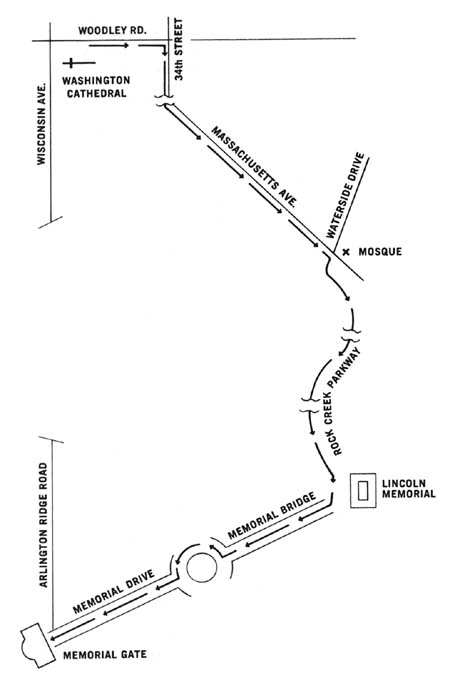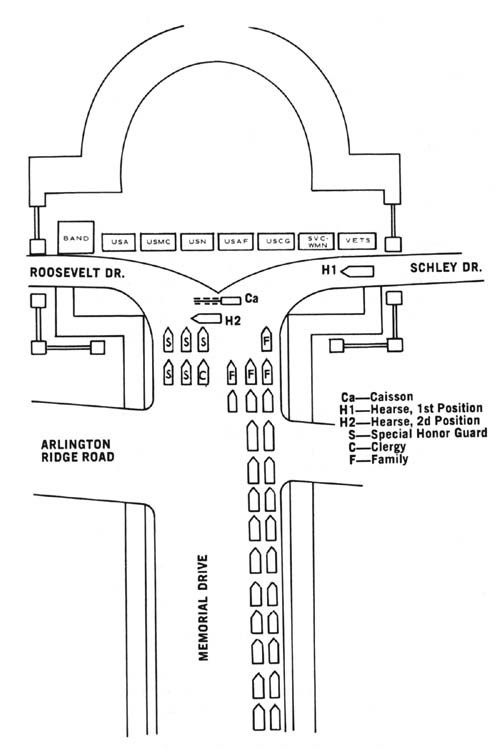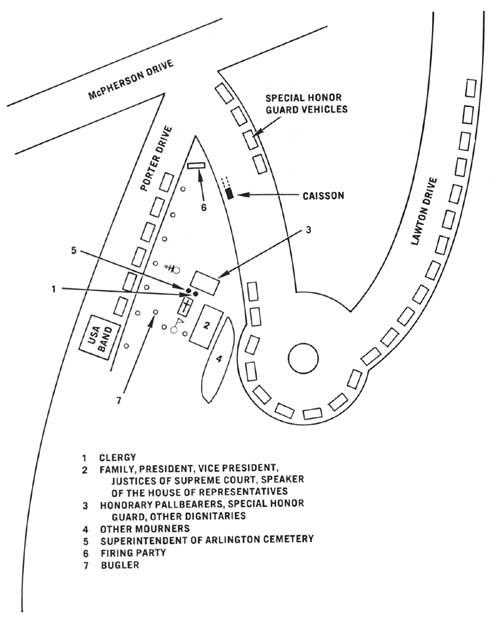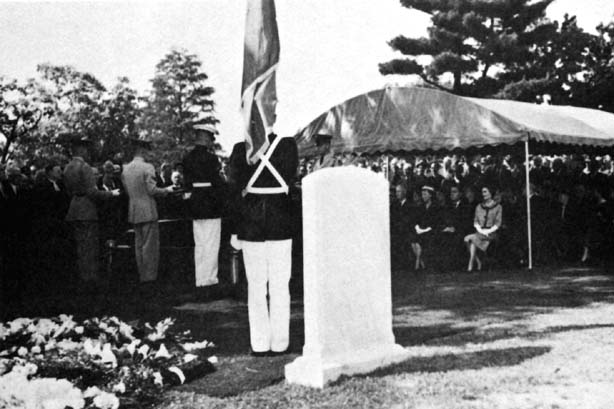|
The
Last Salute: Civil and Military Funeral, 1921-1969
CHAPTER XVI
Former Secretary of State
John Foster Dulles
Official Funeral
24-27 May 1959
After a long illness, former Secretary of State John Foster Dulles
died at Walter Reed General Hospital just before 0800 on 24 May 1959.
President Dwight D. Eisenhower received the word at his farm near Gettysburg,
Pennsylvania. Returning to Washington, the President on the afternoon
of the 24th directed that Mr. Dulles be given an Official Funeral with
full military honors.
Before leaving Gettysburg, President Eisenhower ordered that the flags
at the White House and all other government buildings in the United
States, except the Capitol, and the flags at American embassies, legations,
and consulates abroad be flown at half-staff' until the burial service
for Mr. Dulles had been held. Customarily the flag over the Capitol
is lowered only at the death of a President, Vice President, or member
of Congress. But at the prompting of Congressman William H. Ayres, Republican
of Ohio, who was an ardent admirer of Mr. Dulles, the Congressional
leadership-Vice President Richard M. Nixon, Senate Majority Leader Lyndon
B. Johnson, and Speaker of the House Sam Rayburn - instructed the Capitol
Architect, J. George Stewart, to fly the Capitol flag at half-staff
for Mr. Dulles. Many foreign embassies including that of the Soviet
Union voluntarily lowered their flags also.
The funeral for Mr. Dulles was the first one conducted after policies
and general plans for the Official Funeral had been issued late in 1949
and published with revisions in 1958. (The funeral held for James V.
Forrestal early in 1949 resembled the Official Funeral.) The ceremonies
of the Official Funeral were only slightly less elaborate than those
of the State Funeral; the main difference was that the Official Funeral
did not include a period of lying in state in the rotunda of the Capitol.
Chief responsibility for arranging the funeral rested with the Department
of State and Headquarters, Military District of Washington. As prescribed
in the existing funeral policies, the Department of State was responsible
for coordinating all funeral arrangements since it was the department
of which Mr. Dulles had been a member. The Commanding General, Military
District of Washington, as
[132]
the representative of the Secretary of the Army, who in turn represented
the Secretary of Defense, was in charge of arranging all armed forces
participation in the ceremonies. President Eisenhower also instructed
Brig. Gen. Andrew J. Goodpaster, White House Staff Secretary, to see
that the wishes of Mrs. Dulles were followed implicitly.
According to the plans developed, Mr. Dulles's body was to lie at the
Dulles residence in Washington from noon on 25 May until noon on the
26th, when it was to be moved to the Washington National Cathedral.
There the body was to lie in the Bethlehem Chapel until noon on 27 May,
and the funeral service was to be held in the nave of the cathedral
at 1400 on the 27th. Mr. Dulles himself was a Presbyterian and had been
an elder of the National Presbyterian Church in Washington. The cathedral,
a Protestant Episcopal Church, was selected for the funeral service
because of its large seating capacity of 2,800. The Reverend Roswell
P. Barnes of New York, secretary of the World Council of Churches and
long-time friend of Mr. Dulles, was to lead the clergymen officiating
at the service. To assist him were the Reverend Paul A. Wolfe of the
Brick Presbyterian Church, which was Mr. Dulles's church when he was
in New York, and the Reverend Edward L. R. Elson of the National Presbyterian
Church in Washington. Burial was to take place in Arlington National
Cemetery, by virtue of Mr. Dulles's service as a commissioned officer
on the War Trade Board during World War I. The gravesite, selected by
Mrs. Dulles, was in Section 21, not far southwest of the Memorial
Amphitheater.
Mr. Dulles's body was taken from Walter Reed General Hospital to the
Dulles residence at noon on 25 May by morticians from Gawler's Funeral
Home. At 1100 on the following day, the casket was moved by hearse to
the Washington National Cathedral. Six military body bearers (two Army,
one Marine Corps, one Navy, one Air Force, and one Coast Guard) handled
the casket. In addition, the small motorized cortege moving to the cathedral
included the mortician, the clergy, and members of the Dulles family.
Mrs. Dulles herself remained at home. The cortege halted on the drive
at the south entrance to the cathedral. An honor cordon representing
all services including the Coast Guard flanked the driveway curb and
the walkway to the entrance. Inside this cordon was a second cordon
of friends and associates of the former Secretary whom Mrs. Dulles had
selected to act as honorary pallbearers:
| Thomas E. Dewey |
Edward H. Green |
| C. Douglas Dillon |
Charles C. Glover |
| George M. Humphrey |
Robert F. Hart, Jr. |
| Jean Monnet |
C. D. Jackson Joseph |
| Herbert C. Hoover, Jr. |
E. Johnson |
| John D. Rockefeller 3d |
George Murnane |
| Admiral Arthur W. Radford |
Herman Phleger |
| General Walter B. Smith |
Dean Rusk |
[133]
| General C. Stanton Babcock |
Eustace Seligman |
| Pemberton Berman |
Henry P. Van Dusen |
| Arthur H. Dean |
Morris Hadley |
| Harold Dodds |
|
Near the double cordon stood a national color detail and the verger
of the cathedral. Inside the Bethlehem Chapel waited some eighty members
of the diplomatic corps headed by Mr. Wiley Buchanan, the Chief of Protocol
of the Department of State. Also at hand was a joint honor guard, the
first relief of which would take post around the casket as soon as it
was brought into the chapel.
When members of the cortege had left their automobiles, the body bearers
removed the casket from the hearse and a small procession formed to
escort the body into the chapel, the national color detail leading the
way. Dr. Barnes and the cathedral verger preceded the casket and behind
it came the honorary pallbearers and members of the Dulles family.
Moving through the honor cordon and a cathedral corridor, the body bearers
placed the casket on a velvet-covered bier in the center of the chapel.
Floral tributes had been arranged earlier and a square of velvet rope
surrounded the closed casket. The first relief of the guard of honor
took post inside the rope, one sentinel at each corner of the bier,
the officer in charge at the head of the casket. The Dulles family,
honorary pallbearers, and members of the diplomatic corps gathered outside
the rope. In this setting, Dr. Barnes read from Psalms and offered a
prayer.
At the conclusion of this simple ceremony, about 1230, members of the
public were allowed to enter the chapel, which remained open through
the night and until 1100 on 27 May while thousands of people came to
pay their respects.
On the 27th, in preparation for the funeral service at 1400, troops
supplied by the Military District of Washington reported at the cathedral
at 1000 to complete arrangements for controlling automobile traffic
and parking. At noon twenty seven ushers and twenty guides arrived to
prepare for handling the movement and seating of persons attending the
service. All were of the grades of major or lieutenant colonel, or the
equivalent. The ushers represented all the uniformed services (nine
Army, three Marine Corps, six Navy, six Air Force, and three Coast Guard),
while the guides were Army officers. In charge of both ushers and guides
was an officer from the Military District of Washington.
Troops to cordon off the ceremonial area around the entrance to the
cathedral reported at 1230. An officer and six men of a floral detail
also arrived to handle the transfer of flowers within the cathedral
and from the cathedral to Arlington National Cemetery. About 1300 the
body bearers, who again represented all the armed forces, arrived and
Mr. Dulles's casket was borne from the Bethlehem Chapel to the nave
of the cathedral. At the same time the national colors were posted in
the main chapel and the guard of honor took post around the casket.
[134]
Shortly afterward invited guests and the first members of the official
funeral party, including members of the cabinet, justices of the Supreme
Court, members of Congress, and state and territorial governors, arrived.
About 1345 distinguished foreign dignitaries, the honorary pallbearers,
and a special honor guard were ushered into the cathedral. Among the
foreign dignitaries were Chancellor Konrad Adenauer and Mme. Chiang
Kaishek; the foreign ministers of Great Britain, France, West Germany,
Turkey, Italy, the Netherlands, and the Soviet Union; and the Secretary
General of the North Atlantic Treaty Organization, Paul-Henry Spaak.
The special honor guard included the Chairman of the Joint Chiefs of
Staff, the Army Chief of Staff and Vice Chief of Staff, the Chief of
Naval Operations and the Vice Chief of Naval Operations, the Chief of
Staff and Vice Chief of Staff of the Air Force, the Commandant and Assistant
Commandant of the Marine Corps, and the Commandant and Assistant Commandant
of the Coast Guard. Over the next fifteen minutes, Vice President Nixon
and his party, President Eisenhower and his party, and Mrs. Dulles and
her family were ushered to their seats. Upon the arrival of Mrs. Dulles,
the guard of honor around the casket retired, and the funeral service
was begun.
At the opening of the service a hymn, "O God, Our Help in Ages
Past," was sung by a choir of thirty boys marching down the aisle
from the north transept of the cathedral. Dr. Wolfe, Dr. Elson, and
Dr. Barnes in turn offered prayers and read from the Old and New Testaments.
As Mrs. Dulles had requested, no eulogies were delivered.
At the conclusion of the service, about 1430, the honorary pallbearers
left the cathedral to form a cordon outside the entrance. When they
were in position, the procession formed, the color detail leading. The
clergy preceded the casket, which was followed by the personal flag
bearer, the Dulles family, President Eisenhower and his party, Vice
President Nixon and his party, the mortician, and the rest of the official
funeral party. Members of the procession moved directly to vehicles
for the journey to Arlington National Cemetery.
After the body bearers placed the casket in the hearse, they stood fast
with the national color detail while the cortege formed and departed
for the cemetery. The body bearers, the color detail, and the floral
detail, escorted by police, then moved by a separate route to arrive
at the cemetery ahead of the procession.
Except for the escort commander, Col. Milton S. Glatterer, the deputy
commander of the Military District of Washington, the military escort
did not participate in the move from the cathedral to the Memorial Gate
of the cemetery. The following order of march was observed: police escort,
escort commander, special honor guard, mortician, clergy, hearse, Dulles
family, President Eisenhower, Vice President Nixon, honorary pallbearers,
other dignitaries, police escort. The motorized cortege moved to Memorial
Gate via Woodley Road, 34th Street, Massachusetts Avenue, Rock Creek
Parkway, Memorial Bridge, and Memorial Drive. (Diagram 31) It
took twenty-five minutes to reach the gate.
[135]

Diagram 31. Route of march, Washington National Cathedral
to Arlington National Cemetery.
[136]
On the green at the gate, the military escort was on line facing the
approaching cortege. The U.S. Army Band was at the right of the formation.
To the left of the band, in order, stood a company-size contingent each
from the Army, Marine Corps, Navy, Air Force, and Coast Guard. To the
left of these troops was a composite company of servicewomen and, finally,
a group composed of representatives of seven national veterans' organizations
chartered by Congress. The caisson and body bearers were waiting in
the street opposite the center of the escort formation for the casket
transfer ceremony.
When the cortege reached the gate, guides directed each section to its
proper position for the transfer ceremony. The special honor guard,
leading the procession, formed three cars abreast on the left side of
Memorial Drive. The car carrying the clergy joined this formation. The
hearse was at first guided to a position on Schley Drive to the rear
of the caisson. The cars bearing the Dulles family formed on the right
side of the road, the one carrying Mrs. Dulles in front by itself, the
others behind, three abreast. To the rear of the family cars were those
of the Presidential and Vice Presidential parties, three abreast, and
behind these, also three abreast, were the automobiles of the honorary
pallbearers. The rest of the cortege was in column, two cars abreast,
on the right side of Memorial Drive. (Diagram 32)
When all cars were in position, the hearse moved forward and halted
at the left and a few feet ahead of the caisson. The body bearers and
personal flag bearer then moved into position behind the hearse. The
military escort presented arms and held the salute while the Army Band
played ruffles and flourishes, a slow march, and then a hymn. As the
hymn was begun, the body bearers removed the casket from the hearse
and carried it to the caisson. The hearse left the area. After the casket
was secured on the caisson, the band ceased playing and the military
escort ordered arms, completing the transfer ceremony.
The procession then moved toward the gravesite, starting south on Roosevelt
Drive. Behind the escort commander, the military units marched in column
in the same order in which they had formed in line on the green at Memorial
Gate. The cortege followed much the same arrangement as in the movement
from the cathedral. The following order of march was observed: escort
commander, US Army Band, Army contingent (89), Marine Corps contingent
(89), Navy contingent (89), Air Force contingent (89), Coast Guard contingent
(89), servicewomen contingent (102), veterans' group, special honor
guard, national colors, mortician, clergy, caisson, personal colors,
Dulles family, President Eisenhower, Vice President Nixon, honorary
pallbearers, other mourners. The procession reached the gravesite via
Roosevelt, Wilson, Farragut, McPherson, and Lawton Drives. The cortege
halted on Lawton Drive, which was just north of the gravesite. The military
escort continued past the site, then turned back on Porter Drive to
reach its assigned position just south of the grave. (Diagram 33)
Upon reaching this
[137]

Diagram 32. Formation for casket transfer ceremony (schematic).
[138]

Diagram 33. Route of march, Memorial Gate to gravesite.
position, the escort units halted facing the gravesite; the Army Band
played a hymn while other members of the procession, on Lawton Drive,
left their cars. The grave chosen by Mrs. Dulles was on the brow of
a shaded hill. On one side the floral detail had arranged over a hundred
floral tributes. On the north side, a canopy had been erected to provide
shelter from the sun for the Dulles family and the highest government
officials; the temperature was-in the eighties. From the grave, a carpeted
aisle reached to Lawton Drive, and the caisson had been halted beside
it.
The honorary pallbearers, among the first to dismount, took position
on either side of the aisle. At the same time, the special honor guard
was guided to its graveside position. (Diagram 34) The remaining
mourners stayed on the roadway after leaving their automobiles.
When the members of the Dulles family, last to dismount, were out of
their cars, the military escort presented arms and held its salute throughout
the procession to the grave. The band sounded ruffles and flourishes
and played a march, then began a hymn. As the hymn was played the body
bearers removed the casket from the caisson. Preceded by the national
colors and the clergy, and followed by the personal flag; the casket
was borne between the cordon of honorary pallbearers. When it had passed,
the pallbearers fell in behind and moved to their graveside position.
The body bearers placed the casket on the lowering device. At that
[139]

Diagram 34. Formation at the graveside.
[140]

PROCESSION
MOVES THROUGH THE CEMETERY,
above.
LAST RITES AT
THE GRAVESITE,
below.

[141]
time, the band stopped playing the hymn and the escort
unit ordered arms. The body bearers then raised the flag that had draped
the casket and held it over the casket throughout the graveside service.
Under the direction of the superintendent of Arlington National Cemetery,
Mr. John C. Metzler, the Dulles family and the President and Vice President
and their parties were escorted to seats under the canopy at the graveside.
All other mourners then were guided to a position behind the seated
group. When everyone had found his place, Dr. Elson read the Twenty-third
Psalm. Dr. Barnes then continued the service. At its conclusion, the
military escort presented arms while the battery of the 3d Infantry,
from a distant position in the cemetery, fired a 19gun salute.
At the end of the cannon salute, a rifle squad from the 3d Infantry
fired three volleys, and a bugler sounded taps. In the traditional manner
the body bearers then folded the flag they had held over the casket
and handed it to the cemetery superintendent. Mr. Metzler, in turn,
gave it to a clergyman who presented it to Mrs. Dulles, thus concluding
the funeral rites for former Secretary of State John Foster Dulles.
[142]
Previous Chapter
Next Chapter
|






